9.7 Time Dependent Creep Effects in Prestressed Beams
Subjects Covered
- Construction on Centring
- Staged construction
- Creep Factor
- Ageing coefficient
- Total Construction Effects
- Elevated Temperature Curing Profile
General Background
Annex KK of EN1992-2 is an informative annex related to the structural behaviour of time dependant effects. It is primarily concerned with the redistribution of internal stresses when a bridge is built in stages. A typical example of this effect is produced when a precast prestressed composite beam bridge deck is constructed with the insitu slab being cast onto, and supported by, the un-propped prestressed beams which have already been placed into position. Although there are a number of time dependant effects that may affect the distribution of stresses in the deck, such as concrete shrinkage and prestressing steel relaxation, the effect that generally causes most difficulty, especially when the deck is statically indeterminate, is concrete creep.
Consider the simplest case of a simply supported precast prestressed composite beam with the complete insitu slab cast in one stage after the beams have been placed into position.
1:
Immediately after the slab has been cast the dead loads of both the beam and slab, together with the prestress, are carried by the precast beam alone and there are no stresses in the slab.
2:
After a period of time, in which a certain amount of the total creep has occurred, the bending moments will remain the same but, due to the displacements caused by the concrete creep, the stresses are redistributed such that some of the dead load and prestress will now be carried by the composite section. There are therefore some stresses in the slab.
3:
The degree of redistribution is dependent on a number of parameters, one of which is the relative ages of the insitu and prestressed concrete. Consider the extreme fictitious case where the insitu and prestressed concrete are cast at exactly the same time and all permanent actions are applied at the time that the shuttering is removed. This would result in all permanent moments being resisted by the composite section. This is often referred to as “Construction on Centring”.
The stresses in 2. will be the stresses in 1. (modified to take account of long term losses) plus a proportion of the difference between the stresses in 3. and 1. The basis of the simplified method in Annex KK.7 is to determine what proportion of the difference is to be used based upon an “Ageing coefficient”.
Although this is the simplest of cases, the procedure can be extended to structures that may be statically indeterminate and constructed in a number of stages. In these cases the redistribution of secondary effects of prestress will also be considered as well as redistribution of primary prestress and permanent effects.
Outline of Example
The definition of a two span prestressed beam bridge deck is given in Example 10.1 and will be used for the basis of this example.



The objective of the exercise is to compare the permanent action stresses at the time the bridge is open to traffic (60 days) with those at the end of the bridges life. The top and bottom precast beam and insitu stresses will be compared at the end of the beam nearest the pier and at mid-span. The aging coefficient will be determined by the program.
All other parameters can be found in the outline of Example 10.1
Procedure
General
- Define 2 beams, one for each span ensuring that any time dependant parameters and stage construction details are set. Reduce the number of active tendons in each beam so that the basic stresses at transfer are acceptable. This is necessary so that the correct primary and secondary prestress effects can be established in the line beam.
- Define a line beam combining the two beams into a two span structure and generate the construction and differential shrinkage load effects using the automated load generator.
- Transfer these load effects back to the beam load effect tables for the both spans. This is necessary to enable the correct calculation of the prestress secondary effects in a second line beam analysis.
- In the Automated loading form for dead load set the beam to be continuous from Girder only; this will represent the structure having the permanent and prestressing effects applied to the composite section instantaneously.
- Analyse for dead loads only and transfer the total construction load into the beam load effects table called “Construction on centring” for both spans.
- To evaluate the SLS stresses due to permanent actions in the program at a given time it is necessary to carry out a “nominal” variable action load case analysis at a given time. Therefore a table of “Traffic gr1a TS – For Bending design” will therefore need to be defined, with negligible values entered, to achieve this. This will only be done for Span 1.
Beam Definition
A basic beam has already been defined and can be found in a file called “EU Example 9_7 Span 1.sam”, which can be used to create both spans.
Start the program and in the main menu select File | New Create From Template... to create a new “EU Project”.
Use the main menu File | Titles to change the Project Title to “Time Dependant Effects in a Line Beam” with a sub title of “Example 9.7”. Also change the Job Number: to “9.7” and put your initials in the Calculations by: field before closing the form in the normal way.
At the bottom of the Materials Navigation pane select the task Clear All to delete all materials.
Change the navigation window to Design Beams and use the
 toolbar button to add an Existing Design Beam..., choosing the file “EU Example 9_7 Span 1.sam” to create a linked design beam for span 1.
toolbar button to add an Existing Design Beam..., choosing the file “EU Example 9_7 Span 1.sam” to create a linked design beam for span 1. Right mouse click in the navigation window and select “Break Link” to embed this data into the project. This will of course create the material properties associated with it.
Select the Analysis button in the navigation toolbar to open the analysis form and set the Analyse for: data field to “Transfer”. It can be seen that the compressive stresses at the bottom of the beam far exceed the stress limits.
Click anywhere on the beam side elevation in the graphics window to open the Pre-tensioned Beam Tendon Definition form which will allow editing of the tendon data.
Use the mouse on the section graphics display to window round all the tendons except those in the top and two bottom rows.
Click on the small - button at the bottom of the tendon table to make these tendons inactive.
Click on the ✓ OK button to close the form and return to the analysis.

The analysis graphical display should now show that the stresses are more acceptable and that with some debonding at the ends of the tendons the section will work.
For this example we are going to reduce the curing time from 4 to 3 days but elevate the curing temperature from 20 to 32 degrees. This temperature will be ramped up over three hours and ramped down at the end over 4 hours.
On the Analysis form, select “Time dependent effect calculations” in the Set parameters for field. This opens the “Time Dependent Effect Calculations” form.
Set the Age (in days) at start of drying shrinkage field to a value of “1”.
In the “Elevated Temperature Curing” table near the bottom of the form, click on the + button four times to add four rows to the table.
Set the time in ascending order to be “0,3,68,72” hours and the corresponding temperatures to “20,32,32,20”.
Close the form with the ✓ OK button.
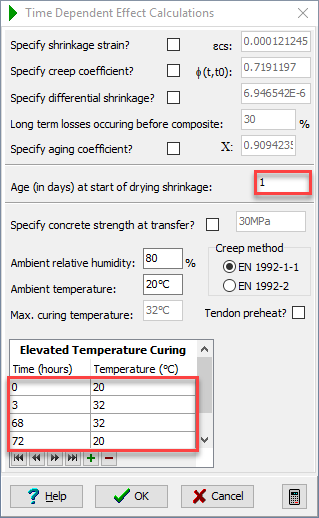
For this example we want to compare stresses without the effects of primary temperature stresses so we need to remove the default differential temperature profile. This is done by changing the Analyse for field to “Differential Temperature Primary Stresses” to open the Diff Temp Analysis form and then changing the Type of profile to “User Defined” and then clicking on the clear button.
Close both the Differential Temperature Analysis and the Pre-tensioned Beam Analysis forms using the ✓ OK button.
Select Beam Definition in the navigation window to open the Pre-tensioned Beam Definition form.
Click on the Define drop down menu and select “Section 1” from the list to open the Pre-tensioned Beam Section Definition form.
Change the Precast Age (days) for the PC beam from 4 to 3 days. This automatically sets the beam in Section 2, so we can now close both forms with the ✓ OK button.
Select the SB1: Prestress Inner Beam - Span 1 object in the navigation window and right mouse click to select “Copy”.
Right mouse click again to select “Reverse” to swap any in-span features so that they are reversed in the span length.
Right mouse click again to select “Rename” to rename the second beam to “Prestress Inner Beam – Span 2”.
Line Beam Analysis for As-Built Construction Load Effects
The line beam analysis needs to be carried out in two parts where the first part defines the load effects for each stage of the construction as it is built.
Click on Add Model | Line Beam in the toolbar at the top of the Structure Definition pane. The Line Beam Geometry form will open.
Set the number of spans to “2”.
Set Span Length in both rows to “21” and both Divide *** Span into fields to a value of “20”.
Close the Line Beam Geometry form using the ✓ OK button.

Open the Structure Properties group on the navigation pane.
At the bottom of the pane select the structure property task Create Section and Beam Groups to define one instance of each of the two Design Beams defined earlier.
Click on the Prestress Inner Beam - Span 1 object in the navigation pane to open the Structure Properties: Beam form.
Set the Properties / Type: fields to “Transformed section” and “beam & slab”.
Click on the left hand span in the graphics window to assign it where the span will be highlighted in red.
Click on ✓ OK to close the form.
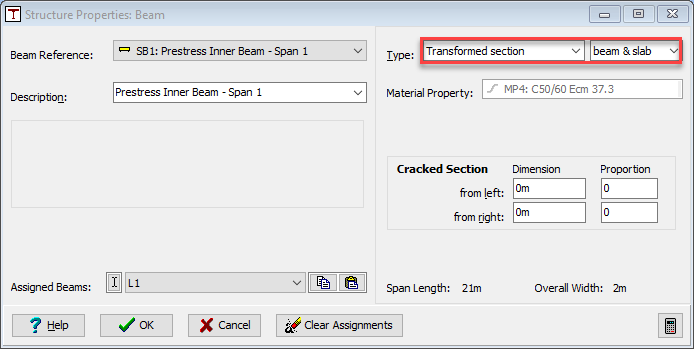
Repeat the last two steps to assign the property Prestress Inner beam - Span 2 to the right hand span.
In the main menu select Data | Automated Loading... to open the Automated Loadings form.
Select the Dead and SDL Loading tab at the top of the form and set the Continuous from stage field to “Stage 2 Concrete”.
Tick the tickbox for Analyse for Shrinkage and ensure that no other boxes are ticked.
Click on the Analyse button. The bending moment for each construction stage should be that for a simply supported beam. This is because the beam only becomes continuous after the stage 1b concrete has hardened.
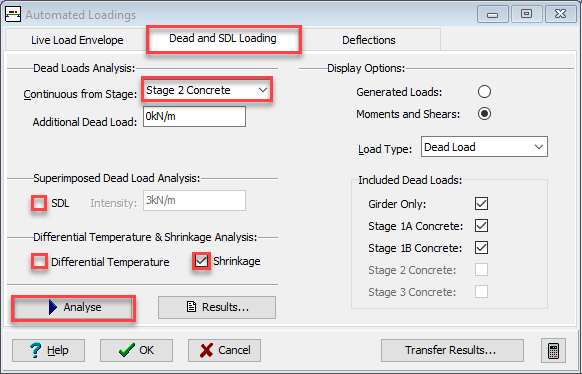

Click on the Transfer Results... button and click on the left span in the graphics window.
Change the Name of the transfer set to “DL Span 1” and then click on the “Set Default Mapping” toolbar button
 at the bottom of the form to map the default construction loads cases to the appropriate load effects tables in the Design Beam.
at the bottom of the form to map the default construction loads cases to the appropriate load effects tables in the Design Beam.Add (+) one more row to include the differential shrinkage load case (note the load factors).

A second transfer set can now be created for the same load cases but for the second span.
Click on the + button in the top right corner of the form to add an additional set.
Set the Name to “DL Span 2” and then replicate the transfer table by clicking on the Copy Transfer Details From button and selecting “DL Span 1”.
To complete this second transfer set, ensure that the second span beam is selected in the graphics window so that the correct Design Beam: is shown in the data form.
Click on the Transfer Results button and select “Transfer All Sets”. A Transfer Report form is displayed which can be closed if all is successful.
The Transfer Results form can also be closed with ✓ OK, but keep the Automated Loadings form open for now. The initial construction stage load effects tables should be complete for both Design Beams.
Line Beam Analysis for “Construction on Centring” Load Effects
The Automated line beam loading now needs to be run again to create the load effects that would occur if the structure and prestress were applied instantaneously. This will be used in the beam design to help calculate the time dependant effects
In the Automated Loadings form set the Continuous from stage field to “Girder Only” and ensure that no tickboxes are ticked.
Click on the Analyse button (Click on “Yes to All” on the confirm form if it appears).
Click on the Transfer Results... button to open the Transfer Results form.
Add an additional transfer set using the + button in the top right corner of the form and change the Name to “COC Span 1”. (Ensure Span 1 is selected).
Add a new data line in the transfer table using the + toolbar button at the bottom of the form. This should be filled in as shown below.
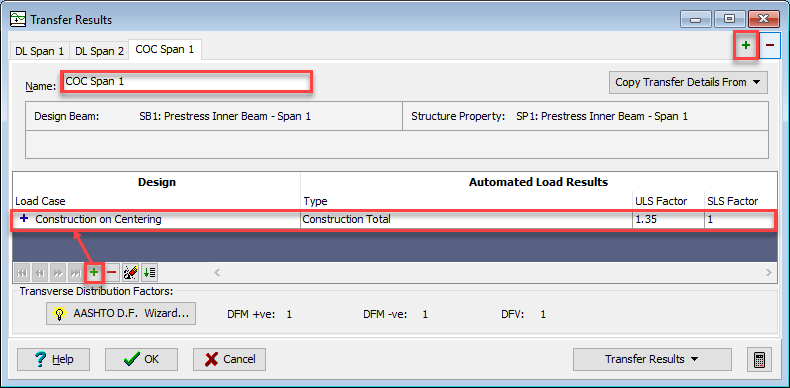
Before transferring the results create a fourth transfer set named “COC Span 2” and copy the table contents from span 1 and ensuring that span 2 is selected in the graphics.
Click on the Transfer Results button and select “Transfer Current Set to Design Beam” which should transfer the results for span 2.
Change the current transfer set to “COC Span 1” by clicking on the tab at the top of the form and then repeat the last step.
The Transfer Results form can now be closed with the ✓ OK button, as well as the Automated Loadings form.
To view these results change the navigation window to Design Beams and select the appropriate Beam Loads table. The results for the “Construction on Centring” loadcase will show that there are three components to this data:
- the external loading
- the primary prestress effects
- the prestress secondary effects
The results below are displayed by selecting the relevant Prestress Effects radio buttons on the form.
I.
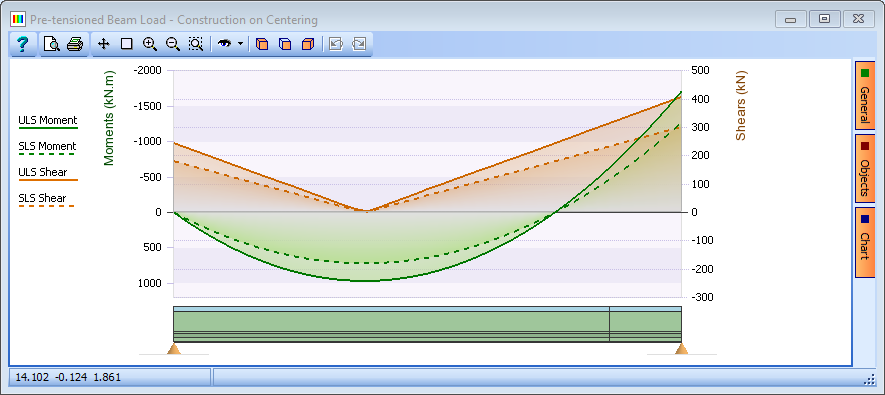
II.
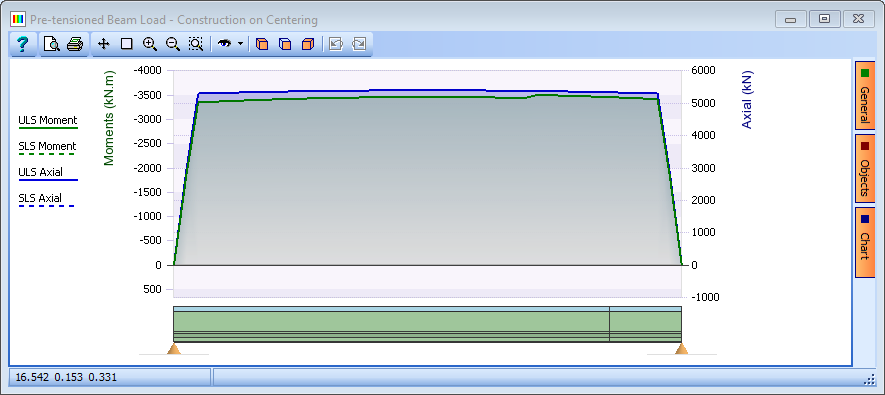
III.
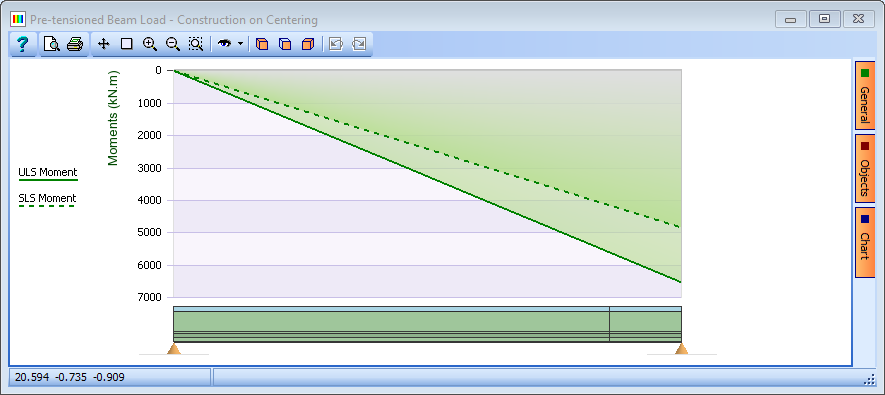
After inspecting this data click ✓ OK on the Define Pre-tensioned Beam Load form.
To inspect the stresses at different times we need to analyse the beam for a nominal live load case so that all the time dependencies are applied correctly, so, a nominal traffic loading with very low values will be created for span 1.
With the span 1 beam selected in the Design Beam navigation window click on the
 toolbar button to add “Beam Loads” for “Traffic gr1a TS – for Bending design”.
toolbar button to add “Beam Loads” for “Traffic gr1a TS – for Bending design”.Click on the “Generate” button and click “Yes” on the confirm form.
Enter the UDL intensity Start and End as “0.00001kN/m” and click ✓ OK to close the Generate Beam Loads form.
Click ✓ OK to close the Define Pretensioned Beam Loads form.
Click on the Analysis toolbar button at the top of the navigation window to open the Pre-tensioned Beam Analysis form.
Set the Analyse for field to “Bending for gr1a 1” and dismiss any confirm and warning forms that may be displayed by clicking “Yes” and ✓ OK as necessary.
Ensure that the Limit State field is set to “SLS Characteristic”.
Set the Time considered to be “61” days and set the point of interest to be at point 14 (20.091m from left end of beam).
Click on the Results button to display the results.
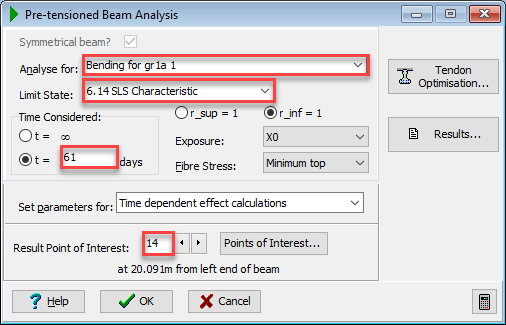
The default graphical display is the stress plots of the top and bottom of the precast concrete. By clicking on the slab in the section view in the graphics window, the display changes to the stresses at the top and bottom of the slab.
Click on the Results button to open the Results Viewer.
Scroll through the Results Viewer until the stress summary is reached.
At the bottom of the stress summary for SLS Characteristic loading, the values of stress at the top and bottom of both prestressed and insitu concrete are displayed and should be the same as those displayed on the graphics. These are:
| Stress | Slab | PC Beam |
|---|---|---|
| Top Stress | 0.014 N/mm² | -1.36 N/mm² |
| Bottom Stress | 0.014 N/mm² | 18.51 N/mm² |
- Just above the Stress Summary Table are the calculations for the “Structural Effects of Time Dependant Behaviour”. The calculated value for the ageing coefficient is 0.90942.
- Change the Time Considered: to be infinity and the stresses are recalculated to be:
| Stress | Slab | PC Beam |
|---|---|---|
| Top Stress | 1.37 N/mm² | 2.57 N/mm² |
| Bottom Stress | 1.07 N/mm² | 11.27 N/mm² |
The calculated value of the ageing coefficient is 0.82948. Below is a summary of the stresses at the section.
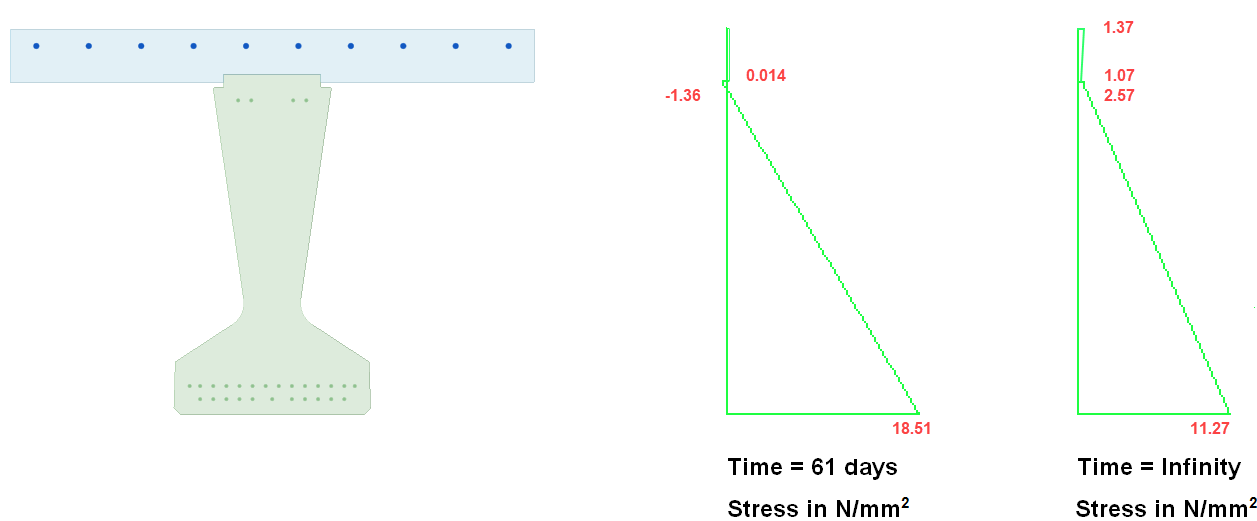
In the main menu select File | Save As to save your model as “My EU Example 9_7.sst”. Close the program.
Summary
This example clearly shows how the program can be used to model the redistribution of concrete stresses in a precast pretensioned beam due to the age dependant effects of creep. Although we have focused on stresses, the redistribution will also have an effect on other design effects such as bending moments and deflections. The stresses above could be resolved into bending moments to determine the redistribution and the change in deflections can be found in the 'SLS Flexure' table at the end of the analysis reports.
